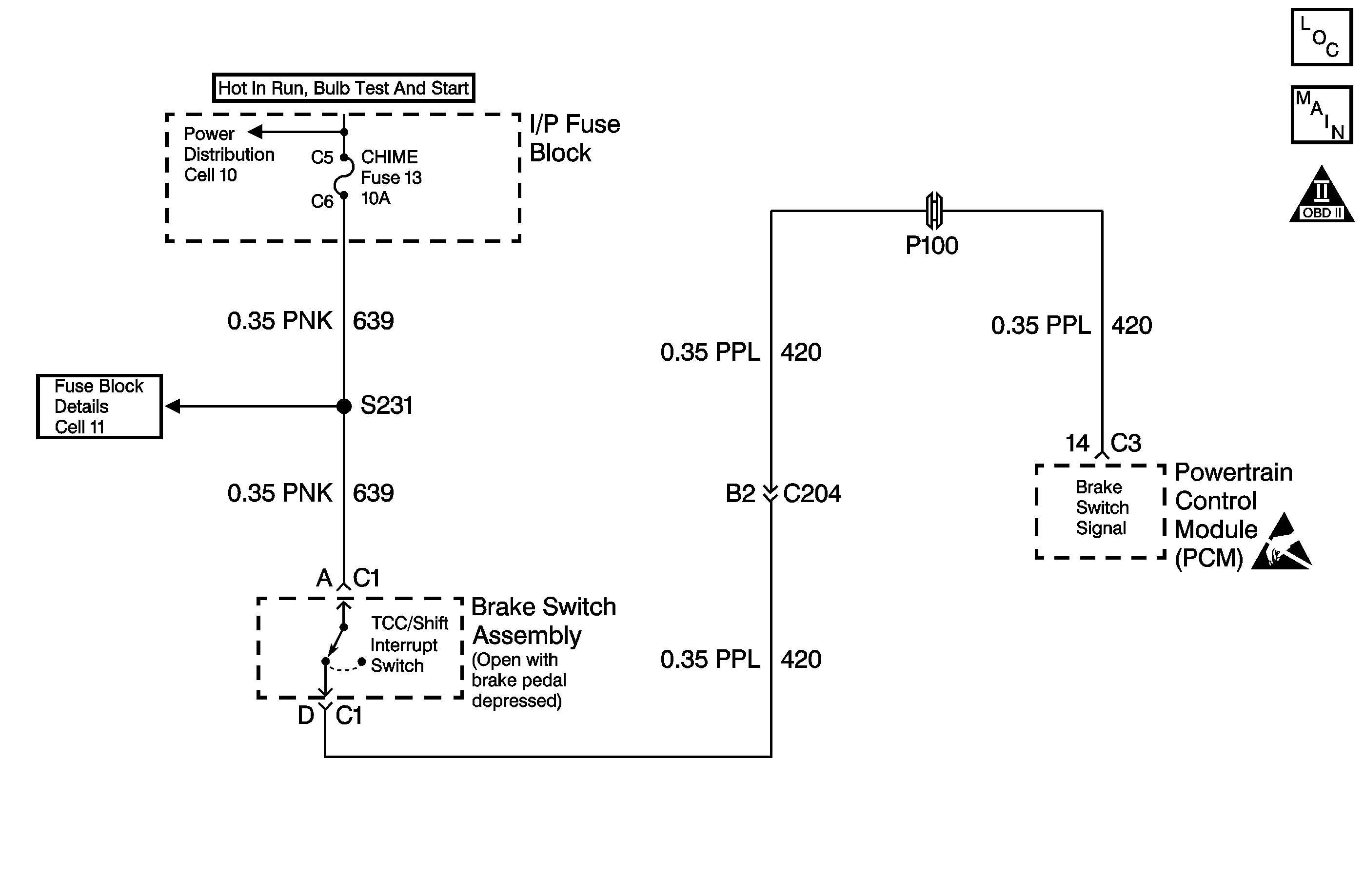
Circuit Description
The TCC/Shift Interrupt switch indicates the brake pedal status. This normally-closed switch, within the Brake Switch Assembly, supplies a B+ signal on circuit 420 to the PCM. The signal voltage circuit opens when you apply the brakes. The PCM uses this signal to de-energize the TCC Solenoid Valve.
If the PCM detects a closed brake switch during a deceleration, then DTC P0724 sets. DTC P0724 is a type D DTC.
Conditions for Setting the DTC
| • | No VSS DTC P0502. |
| • | The PCM detects a closed brake switch/circuit (12 volts) for 2 seconds and the following sequence of events occur seven consecutive times: |
| - | The vehicle speed is greater than 32 km/h (20 mph) for 6 seconds; |
| - | Then the vehicle speed is 8-32 km/h (5-20 mph) for 4 seconds; |
| - | Then the vehicle speed is less than 8 km/h (5 mph). |
Action Taken When the DTC Sets
| • | The PCM freezes shift adapts from being updated. |
| • | The PCM will not illuminate the Malfunction Indicator Lamp (MIL). |
Conditions for Clearing the DTC
| • | A scan tool can clear the DTC from the PCM history. The PCM clears the DTC from the PCM history if the vehicle completes 40 warm-up cycles without a failure reported. |
| • | The PCM cancels the DTC default actions when the fault no longer exists and the ignition is OFF long enough in order to power down the PCM. |
Diagnostic Aids
| • | Inspect the wiring for any poor electrical connections at the PCM. Inspect the wiring at the brake switch assembly. Look for the following conditions: |
| - | A bent terminal |
| - | A backed out terminal |
| - | A damaged terminal |
| - | Poor terminal tension |
| - | A chafed wire |
| - | A broken wire inside the insulation |
| • | When diagnosing for an intermittent short or an open condition, massage the wiring harness while watching the test equipment for changes. |
| • | Ask the customer about the customer's driving habits. Ask if the customer has any unusual driving conditions (e.g. stop-and-go, expressway, etc.). |
| • | Check for the most current calibration ID. Check for the latest bulletin. |
| • | Inspect the brake switch assembly for proper mounting. Inspect the brake switch assembly for proper adjustment. |
Test Description
The numbers below refer to the step numbers on the diagnostic table.
-
This step tests for voltage at the brake switch assembly.
-
This step tests the TCC/Shift Interrupt switch.
Step | Action | Value(s) | Yes | No | ||||||
|---|---|---|---|---|---|---|---|---|---|---|
1 | Was the Powertrain On-Board Diagnostic (OBD) System Check performed? | -- | Go to Powertrain On Board Diagnostic (OBD) System Check , Section 6. | |||||||
2 |
Important: Before clearing the DTCs, use the scan tool in order to record the Freeze Frame and the Failure Records for reference. The Clear Info function will erase the data. When you apply the brake pedal, does the scan tool display the TCC Brake Switch as Applied , then as Released when you release the brake? | -- | Go to Diagnostic Aids | |||||||
Did the test lamp illuminate? | -- | |||||||||
4 |
Did the test lamp illuminate? | -- | ||||||||
5 | Repair the open in ignition feed circuit 639 to the brake switch assembly. Is the repair complete? | -- | -- | |||||||
Apply the brake pedal. Is the test lamp OFF when you apply the brake pedal? | -- | |||||||||
7 | Apply the brake pedal. Release the brake pedal. Does the scan tool display TCC Brake Switch as Applied when you apply the brake, and does the scan tool display Released when you release the brake pedal? | -- | Go to Diagnostic Aids | |||||||
8 | Examine the brake switch assembly for proper adjustment. Did you find and correct a problem? | -- | ||||||||
9 | Inspect circuit 420 for a short to Battery Positive Voltage. Refer to Electrical Diagnosis, Section 8. Did you find a short? | -- | ||||||||
10 | Replace the brake switch assembly. Refer to Brake Switch Assembly Replacement, Section 5. Is the replacement complete? | -- | -- | |||||||
11 |
Did you find and correct a problem? | -- | ||||||||
12 | Replace the PCM. Refer to Powertrain Control Module Replacement/Programming , Section 6. Is the replacement complete? | -- | -- | |||||||
13 |
Has the test run and passed? | -- | System OK | Begin the diagnosis again. Go to Step 1 |
